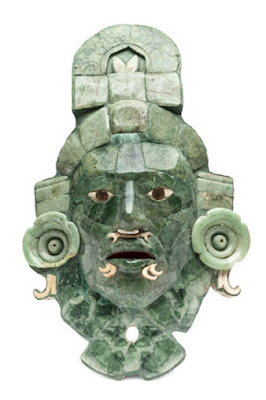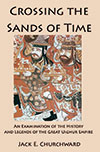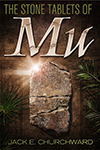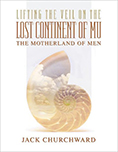Recently I was asked by a Spanish language friend (Débora Goldstern from Argentina) to answer some questions. The Spanish language questions and answeres were published under the title Jack Churchward -El Legado de Mu – Entrevista Exclusiva – Débora Goldstern. For the convenience of my English speaking friends, the original English language questions and my answers are published below:
1. How do James Churchward’s theories of the Lost Continent of Mu fit in with other theories of lost continents since the scientific community has rejected these earlier theories, such as Atlantis and Lemuria?
Writings about Atlantis by the philosopher Plato in the 4th century BCE inspired further writings and research in later centuries, including Sir Francis Bacon and others. Examining the historical context for these writings, it could be speculated that when the authority of religious institutions was weakened by the advent of the acceptance of scientific reason, the earlier Biblical interpretations of man’s beginnings began to be questioned. The situation where alternate theories were regarded as heretical (and possibly life-ending) gave way to allowing free thought. The scientific theory of Deep Time, where the Earth is not just 6,000 years old as believed by Biblical scholars, but many millions of years old, provided the opportunity to ‘fill-in-the-blanks’ for the millions of years previously undocumented. Sunken continents were proposed to account for the distribution of plant and animal fossils and by no means was Lemuria the only one proposed. The advancement of the theory of Plate Tectonics discarded the need for sunken continents and when studies were conducted on the mechanisms of how the continents rearranged themselves, isostasy, or the gravitational equilibrium between the crust and mantle, indicated that the continents could not sink because they ‘floated’ on the mantle. This is how/why science rejected the idea of sunken continents.
James Churchward wrote in the 1920s of his adventures in India as a Colonel in the Bengal Lancers where he befriended a Rishi who eventually showed him the Naacal tablets, ancient writings that he was also taught to interpret. These tablets purportedly told the story of a sunken continent of which the Rishi was one of the three living survivors of the great, advanced civilization of Mu. The writings on Freemasonry by his brother, Dr. Albert Churchward, also influenced James. He was a friend of Augustus LePlongeon, a Mayanist that believed that the Yucatan was the birthplace of humankind and according to James’ unpublished biography, spent many hours discussing the topic with many people, including Theosophists, in New York City in the late 19th century. James theories departed from earlier theories of sunken continents in that he named the continent Mu, and placed it in the middle of the Pacific Ocean. Another characteristic of his writings is that he openly attacked science, belittling scientific conclusions and theories which disagreed with his material.
2. Through James’ writings, it appears that he was able to escape the traditionally strict educational standards and open his mind to be initiated in ancient mysteries concerning Mu. What caused him to develop his new ideas and theories that were so much at odds with his traditional education?
James was born in 1851 to an old English family in Devonshire. A note in one of his scrapbooks mentions going to school in Torquay, Devon. At age 19, he was a bank clerk in London and in 1871 married Mary Julia who had inherited tea plantations in Sri Lanka (then called Ceylon.) James and his new wife moved to Sri Lanka and began the life of plantation owners. I believe his change in beliefs came from the interactions with the people he met in Sri Lanka and India, from his journey across the Pacific, as well as the Sunday afternoon discussions as previously mentioned.
3.In the 1926 Lost Continent of Mu Motherland of Men, the Naacal Tablets form the central argument for the existence of Mu. The 1931 Lost Continent of Mu, the Naacal Tablets are supported by William Niven’s discoveries in the Valley of Mexico, which James Churchward wrote were also representative of the information in the Naacal tablets. What do you think is controversial about what he wrote?
First I would mention that no one other than James ever came forward and said they saw the Naacal tablets. He was severely criticized after the publication of the 1926 Lost Continent of Mu Motherland of Men and accused of inventing them. Prior to the 1926 publication, James had not met nor corresponded with William Niven about his discoveries even though he included an article by William Niven and pictures from his excavations that formed a whole chapter in the book. Niven began a correspondence with Churchward in 1927 that lasted some years and eventually sent images of some 2500 of 2600 tablets he had discovered. For Christmas 1927, James wrote a small ‘book’ that provided illustrations and interpretations of some of the tablet images he had received from Niven for his publisher, Edwin Rudge. This work was entitled, Copies of Stone Tablets Found By William Niven in Santiago Ahuizoctla Near Mexico City and was been hidden away in a library for decades. After I received a pdf scan of the original, I transcribed the text and cleaned up the images to include as an appendix in my recent book, The Stone Tablets of Mu. This book provides background information about Niven, his excavations, Churchward and media reports at the time about his discoveries as well as how the tablets in Copies of Stone Tablets… were used in subsequent books by James.
The facts show that James was the only person to declare to have seen the Naacal Tablets and after corresponding with William Niven used his tablet discoveries from the Valley of Mexico as another source of proof of his theories by tying them to the Naacal tablets. In the 1926 Lost Continent of Mu Motherland of Men, James included four unnumbered images of Niven’s tablets and some interpretations. In the 1926 Lost Continent of Mu, there were 49 images of Niven’s numbered tablets and interpretations for each of them.
4. Churchward wrote about the lost ruins of Khara Khota in the 1926 Lost Continent of Mu Motherland of Men and other books. He proclaimed to have once been the capital of the Great Uighur Empire that was more than 19,000 years old. History tells us that Khara Khota was a city in the Western Xia Dynasty. Should this information be stated?
Yes, although Khara Khota was an important city in the Tangut empire in the 11th century. The Tangut were a Tibetan people that migrated north and their empire was known as the Xi Xia or Western Xia. They were not Chinese and were at odds with the Song and Liao dynasties. The Song Dynasty rulers were even sending tribute to the Xi Xia. With regards to being a ‘lost’ city, Khara Khoto was mentioned in Marco Polo’s writings as the city of Etzina in the 13th century.
Contained in my book, Lifting the Veil on the Lost Continent of Mu Motherland of Men, is a newspaper clipping from one of James’ scrapbooks that contains more information on Khara Khota and much of the story in his books comes from this clipping. Although I have been requesting further information to further collaborate what James wrote about the Great Uighur Empire, I have received none.
5. You mention in many interviews that you do not feel your research is a continuation of your great-grandfather’s work, how does Lifting the Veil on the Lost Continent of Mu Motherland of Men fit within the Mu universe?
My research is not a continuation of my great-grandfather’s work. After many years of being questioned about my great-grandfather and his theories, I decided to conduct my own research into his life and theories. That is why my research is contained in the domain, my-mu.com. This is my impartial research and I have no financial interest in the publication of any of my great-grandfather’s books. Unlike some others, I am free to publish what I discover in the course of my research without fear of losing income.
In Lifting the Veil on the Lost Continent of Mu Motherland of Men, it is my intent to look at the sources James Churchward used. To that end, I included the original 1926 text, added 270 new footnotes and two appendices that cover the authors and books that make a significant contribution to the book. The information is presented without any judgment on my part; each reader is free to make up his or her own mind about the veracity of the content.
6. Lost Gems of the Lost Continent of Mu, an eBook in the my-mu.com bookstore, contains some of James Churchward’s correspondence with others about his theories and writings. What is your assessment of this collection of letters?
The letters and other material in Lost Gems of the Lost Continent of Mu were contained in some of James’ scrapbooks. The contents show that James maintained a correspondence with many people and provide the opportunity to see a more complete picture of James Churchward for the reader.
7. In recent years there have been some news of discoveries that may point to the existence of Mu, such as off the coast of Japan in Okinawa at Yonaguni and some strange writings that could be linked to the script of Mu. Are we witnessing the remnants of Mu or should we expect stronger discoveries?
In my opinion, the concept of Mu as a now-sunken continent covering the Pacific Ocean has been shown to be unlikely. However I am not so arrogant to dismiss the existence of an advanced ancient civilization in a different location just because we have yet to find the evidence. The scientific concepts of man’s origins continue to change almost monthly and we may never know the entire truth about mankind’s past on this planet.
As far as the structure off of Okinawa known as the Yonaguni monument, at the end of the last Ice Age it is supposed that it was above water and some of it may have been worked by humans. On the other hand, geologists that have studied the formation indicate that geological processes could also be the guilty party. Most likely, it is a combination of the two.
8. There are enigmatic structures in the Andes that appear to point to being connected to Mu. Do you think there is a connection that links Mu with South America?
I believe the structures appearing to be of advanced manufacture in South America could be evidence of an advanced civilization, however just because today we are unable (or unwilling) to rationalize the methods used to create these structures does not mean that the indigenous people did not create them.
9. Another eBook available from the my-mu.com bookstore are the translations of letters from Hungarian Dr. Jozep Czerep to James Churchward. What can be said of his work with regards to America’s role as the ‘motherland of man?’
Dr. Czerep’s study of ancient documents yields some interesting information and shows that James’ works also influenced other researchers and scientists.
In my opinion, today’s genetic evidence indicates that the human race emerged from Africa and populated the Earth in several waves. I am not arrogant enough to believe that any human alive knows the complete history of humankind, but what the evidence shows today is that mankind originated in Africa and not Asia or the Americas.
10. A recent controversy concerning Thomas Ritter and his assertion that he had discovered the Naacal tablets in India was found to be fraudulent. Will his story cause a setback to the academic discussion of Mu in the future?
Thomas Ritter, who leads tours to India from Europe, wrote a magazine article that detailed his supposed discovery of the Naacal tablets in a temple in India, including monks that remembered my great grandfather. Since the monks would have to be well over 130 years old, this was the first clue indicating the story was a fraud. After further correspondence with Mr. Ritter, he supplied pictures of what he identified as the Naacal Tablets. These pictures did not look like anything James had shown as the Naacal tablets and included a picture of a metal tablet from a Beirut, Lebanon museum that was definitely not from Mu.
I do not believe that an academic discussion of Churchward’s theories of Mu will ever be conducted.
11. Some people say that James Churchward was not the first person to come up with the idea of Mu and others wrote about it before he did. What is your feeling of these allegations?
It is true that other people wrote about the continent of Lemuria before James did. Augustus LePlongeon wrote about Queen Moo and how Atlantis was renamed Moo in her honor.
On the other hand, James never referred to his lost continent as Lemuria and his continent was named Mu, not Moo.
A very cursory examination of the different theories of ancient civilizations lost in the Pacific Ocean could lead someone to come to the conclusion that they are all alike, however a closer study of the theories yields a different answer. Sure, many of them are alike in that the ancient civilization sunk beneath the waves, but beyond that, they are quite different. Theosophy’s Lemuria was millions of years old and inhabited by not yet fully humans. Other theories place Lemuria in different places and different times, – all with different specifics about the people, how they lived, what technologies they used, etc. I would have to state that each of the stories is different and although some elements are similar, each of them is independent.
12. The Lemurian Fellowship considers that they are the heirs to the knowledge of Lemuria. What is your opinion?
The Lemurian Fellowship was founded in 1936 with the purpose of building a new civilization based on their knowledge from the Lemurian Brotherhood, an ancient mystery school maintaining the wisdom of the Lost Continent of Mu. Being that James never used the name ‘Lemuria’ in any of his writings and the keepers of the ancient wisdom in his books were the Naacals, I do not see a connection.
13. Legends about Mount Shasta have been around for more than a century with tales of advanced civilizations living in tunnels under the mountain. Are these legends credible or just part of local legends?
The first mention of the Mount Shasta stories was in in the late 19th century, many years before James authored his first book on Mu. Some writings suggest that Mount Shasta is the location where survivors of Mu or Lemuria came after the destruction of their homeland or that aliens from outer space landed there many years ago and still live there. There are many different stories about the advanced civilizations under Mount Shasta and like the stories of Lemuria, have various specifics that make them different. One thing they all have in common is that no proof or concrete evidence has been offered. I do not believe all that the stories are credible.
14. If you were offered to lead an expedition to find the remains of Mu, what is the place to start?
As much of the world’s population today lives along the coast, I would expect that the same would be true for ancient peoples. At the end of the last Ice Age, the coast was miles further out, therefore the place to start would be an area that was dry land at the end of the last Ice Age and now covered with water. To narrow it down even further, I would closely examine the ocean floor to search for the course of ancient rivers and search along the ancient shoreline for formations that would be adaptable to facilitate human habitation. This would include natural protected harbors, anomalous mounds or small hills, and anything with nominal straight lines or right angles. This data would be cataloged, categorized and marked on a map. After the survey is completed, the areas with the highest concentration of formations with the highest probability of human habitation would be visited. Core samples would be taken and an underwater survey would take place. Analysis of the core samples, composition of rock samples, and layout of the area could convince someone to fund the development of the technology necessary to explore the area up to 200 feet under water.
Although it may not be a search for the lost continent of Mu, William Niven’s discoveries in the Valley of Mexico have the appearance of an enigma. As I discuss in my book, “The Stone Tablets of Mu,” the description of his discoveries talked about statues resembling many peoples from Asia, Africa, and the Middle East and the existence of ancient wall murals “rivaling those of Babylon, Nineveh, and as old as Thebes.” The lifestyle of these people Niven found underneath two civilizations and volcanic ash did not include struggling to survive. They were a people who built solid permanent structures and had enough time away from basic survival to paint exquisite murals, create detailed gold jewelry, and carve symbols and figures into hard andesite rocks. From the statues of people from around the world, one could speculate that they knew these people and interacted with them. The evidence points to an ancient cosmopolitan civilization with technology. Whether or not the ancient people of the Valley of Mexico were connected to the lost continent of Mu or not, I have been unable to find an academic discussion of Niven’s discoveries. Maybe the newspaper accounts at the time were exaggerated, but not everything can be dismissed.
15. What are your recommendations to all those initiated in the mysteries of Mu?
I would suggest that they work on interpersonal skills and create positive interactions with everyone they come in contact to make this a better world. Technology alone will not advance our civilization; it is not a magic pill to solve all our problems. Even if we found the advanced technology that the ancients used tomorrow, the world would still be the same. On the other hand, mutual respect for our fellow human beings and the recognition of our shared human existence can put us on a path towards a greater civilization.










 RSS - Posts
RSS - Posts